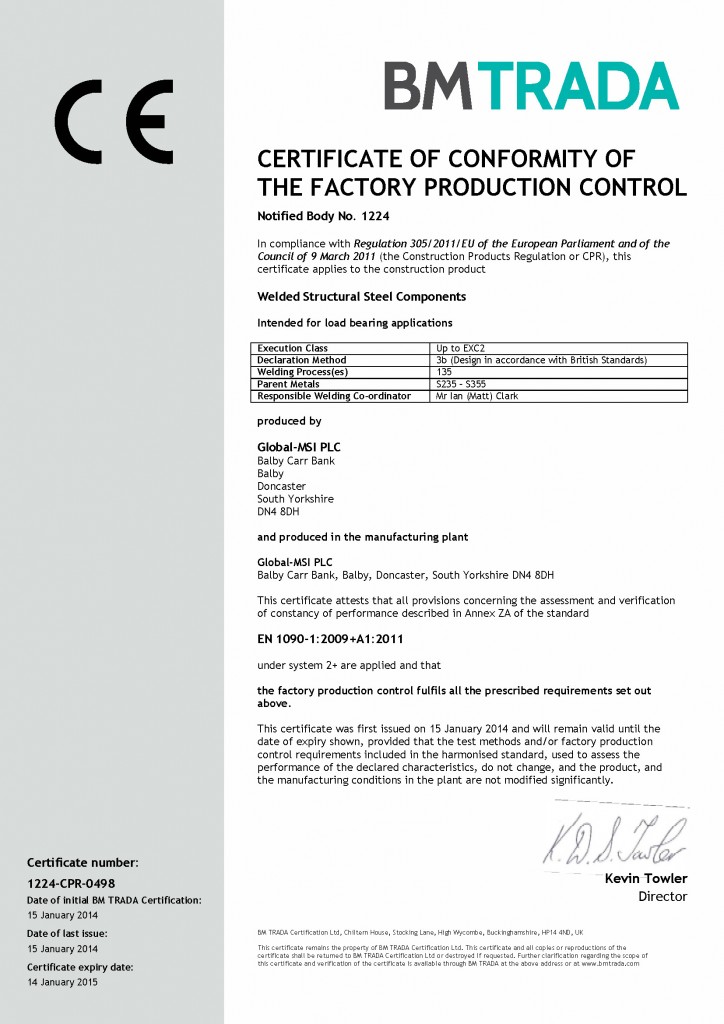Dear Customer,
The construction industry is facing one of the most significant changes for a decade as CE Marking of construction products becomes mandatory in all member states throughout the European Union. CE Marking for all construction products, covered by a harmonised European standard or conforming to a European Technical Assessment became mandatory from 1st July 2013, and a year later (1st July 2014) will become mandatory for fabricated structural steelwork.
Background
With effect from the 1st July 2013 the Construction Products Regulations 2013 (CPR) came into force in the United Kingdom. This placed legally binding obligations on everyone in the supply chain from that date. This applies in 2 parts.
1. The first relates to constituent Structural Steel Products used in construction and is effective from 1st July 2013. (For petrol station canopies this includes cold rolled steel purlins, sheeting, bolts and fixings).
2. The second part relates to Fabricated Structural Steel Components used in construction and is effective from 1st July 2014. (This will typically include hot rolled steel and gutters).
The CPR requires that Fabricated Steel Products are CE marked after 1st July 2014 when the European Harmonized Standard for fabricated steel products BS EN 1090-1 and BS EN 1090-2 comes into force.
These new regulations represent a major development for clients, architects, engineers, contractors and steelwork specialists and demand careful attention to the new obligations imposed. Steel fabricators must comply with the Construction Products Regulation to ensure that they are not breaking the law. Failure to do so invalidates contractual agreements, insurances, bonds and warranties.
Execution Class
BS EN1090-2 introduces the concept of execution class. This enables specifiers to select the level of quality management suitable for the construction product. The execution classes are as follows:
EXC1 Farm Buildings
EXC2 Buildings
EXC3 Bridges, Stadia etc
EXC4 Special Structures such as Power Stations, Long Span Bridgeworks etc
It should be noted that steelwork contractors with EXC3 capability can be used for EXC1, 2, & 3; and a steelwork contractor with EXC2 capability can only be used for EXC1 & 2.
Client obligations
In order to comply, the client or main contractor is obligated to appoint a steelwork contractor with an Execution Class equal to that required for the project, as determined by BS EN 1090.
The client or main contractor engaging the steelwork contractor should carry out due diligence before appointing any steelwork contractor who will be delivering fabricated structural steelwork to site on or after 1 July 2014. Likewise, insurers should complete a similar due diligence process before giving Professional Indemnity insurance to a steelwork contractor who wants to CE Mark their products.
Contracts for fabricated structural steelwork to be delivered to site on or after 1st July 2014 must be CE certified. This certification includes the obligations of BS EN 1090-1 and BS EN 1090-2 on the steelwork contractor. It will therefore be a legal requirement for all fabricated structural steelwork delivered to site from that date to be CE Marked.
Global-MSI compliance
Global-MSI is fully compliant with the BCSA standard conditions of supply and the National Structural Steelwork Specification V5 CE Marking Version when requesting Execution Class 2: Buildings.
GGlobal-MSI is able to provide a CE Marked structural steel frame to EN1090 now, including constituent products such as structural fasteners and cold rolled steel.
Summary
The 1st July 2014 will see the introduction of CE Marking for fabricated steelwork, so from this date it will be a legal requirement for organisations to CE Mark all fabricated structural steelwork. CE Marking will be regulated by Criminal Law, and those found in breach of this duty face penalties including fines and/or imprisonment.
Compliance with the requirements of BS EN 1090-1 is no small task and places obligations on the steelwork contractor that are onerous and take significant time to put into place. To eliminate the risk of non-compliance with the CPR, it is necessary that clients and main contractors only award projects that will have fabricated structural steelwork delivered to site after 1 July 2014, to steelwork contractors who have already achieved CE Marking accreditation.


